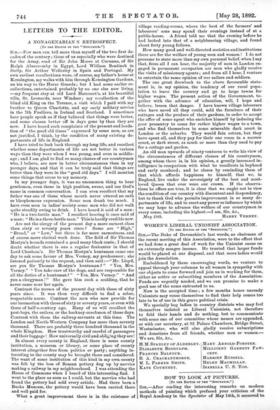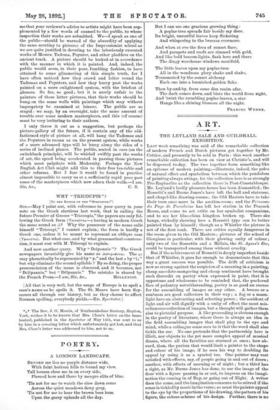HOW TO LOOK AT PICTURES.
[TO TEM EDITOR OF THE "SPECTATOR."]
SIR,—After reading the interesting remarks on modern methods of painting which prefaced your criticism of the Royal Academy in the Spectator of May 14th, it occurred to
me that your reviewer's advice to artists might have been sup- plemented by a few words of counsel to the public, to whose inspection their works are submitted. We—I speak as one of the public—should be warned of the absurdity of applying the same scrutiny to pictures of the Impressionist school as we are quite justified in devoting to the laboriously executed works of Messrs. Tadema, Poynter, and other plodders on the ancient track. A picture should be looked at in accordance with the manner in which it is painted. And, indeed, the public would seem, in their poor, fumbling fashion, to have attained to some glimmering of this simple truth, for I have often noticed how they crowd and loiter round the Tademas and Poynters, and how they hurry past the works painted on a more enlightened system, with the briefest of glances. So far, so good ; but it is surely unfair to the painters of these latter pictures, that their works should be hung on the same walls with paintings which may without impropriety be examined at leisure. The public are so stupid : we may, by an oversight, take the same amount of trouble over some modern masterpieces, and this (of course) must be very irritating to their authors.
I only throw it out as a suggestion, but perhaps the picture-gallery of the future, if it contain any of the old- fashioned style of picture at all, will hang the Tademas and the Poynters in rooms as on the present system, while works of a more advanced type will be hung along the sides of a series of inclined planes. The public, seated in cars (on the switchback principle), will be whirled swiftly past the works of art, the speed being accelerated in passing those pictures which most palpitate with Modernity. Perhaps the New English Art Club might add this to their free tea-table and other reforms. But I fear it would be found in practice almost impossible to carry us at a sufficiently rapid pace past some of the masterpieces which now adorn their walls.—I am,







































 Previous page
Previous page